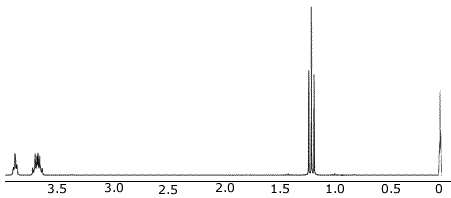1H Nuclear Magnetic Resonance Spectroscopy Tutorial
Key Concepts
- Nuclear Magnetic Resonance Spectroscopy, or NMR Spectroscopy, can be used to identify any isotope unless the isotope has both an even number of protons and an even number of neutrons.
- The nuclei of many elements, such as 1H, spin generating a magnetic field.
When placed in a strong external field they align themselves either with or against the field.
When the sample is irradiated with radio waves the energy absorbed corresponds to the difference between these two magnetic alignments. - 1H NMR Spectroscopy (proton nuclear magnetic resonance spectroscopy) is used to identify the structure of organic (carbon) compounds.
1H NMR spectra provide information about:
- The Number of Signals: each chemically different proton in a structure is also magnetically different.
CH3 groups are chemically different to CH2 groups and to CH groups.
eg, CH3CH2CH2Cl contains 3 chemically different groups of protons:
CH3
CH2 adjacent to CH3
CH2 covalently bonded to Cl - The Relative Areas of Each Signal: the strength of the NMR signal is proportional to the number of protons giving rise to that signal, or, the area under the absorption curve is proportional to the number of protons.
- The Position of the Signal with respect to an internal standard (chemical shift): tetramethylsilane, (CH3)4S or TMS, is often used as an internal standard since almost all proton signals appear downfield from the TMS signal.
On the δ scale, the TMS signal is 0 ppm, and on the τ scale, the TMS signal is 10 ppm. The two scales are related in that δ + τ = 10.
Tables of chemical shifts are derived from measurements of a large number of samples and represent a "normal" range.
Proton signals affected by highly electronegative elements are shifted further downfield. - The Influence of One Proton on Adjacent Protons (magnetic coupling or spin-spin splitting): neighbouring protons in chemically different groups may either reinforce or subtract from the effective force of the applied field, the net effect of this is to split the proton signal.
The proton signal will be split into n + 1 peaks by n adjacent protons.Number of Adjacent
Chemically Different ProtonsNumber of Peaks in a Signal
n + 1Name Given
to Signal0 0 + 1 = 1 singlet 1 1 + 1 = 2 doublet 2 2 + 1 = 3 triplet 3 3 + 1 = 4 quartet 4 4 + 1 = 5 quintet

 H
H